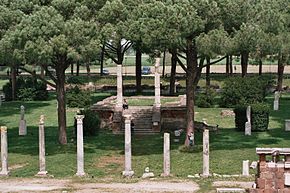Ostia Antica

Market square of Ostia Antica
|
|
| Location | Ostia, Province of Roma, Lazio, Italy |
|---|---|
| Coordinates | 41°45′21″N 12°17′30″E / 41.75583°N 12.29167°ECoordinates: 41°45′21″N 12°17′30″E / 41.75583°N 12.29167°E |
| Type | Settlement |
| History | |
| Cultures | Ancient Rome |
| Site notes | |
| Website | www |
Ostia Antica is a large archeological site, close to the modern suburb of Ostia, that was the location of the harbour city of ancient Rome, which is approximately 30 kilometres (19 miles) to the northeast. "Ostia" (plur. of "ostium") is a derivation of "os", the Latin word for "mouth". At the mouth of the River Tiber, Ostia was Rome's seaport, but due to silting the site now lies 3 kilometres (2 miles) from the sea. The site is noted for the excellent preservation of its ancient buildings, magnificent frescoes and impressive mosaics.
Ostia may have been Rome's first colonia. According to the legend Ancus Marcius, the semi-legendary fourth king of Rome, first destroyed Ficana, an ancient town that was only 17 km (11 mi) from Rome and had a small harbour on the Tiber, and then proceeded with establishing the new colony 10 km (6 mi) further west and closer to the sea coast. An inscription seems to confirm the establishment of the old castrum of Ostia in the 7th century BC. The oldest archaeological remains so far discovered date back to only the 4th century BC. The most ancient buildings currently visible are from the 3rd century BC, notably the Castrum (military camp); of a slightly later date is the Capitolium (temple of Jupiter, Juno and Minerva). The opus quadratum of the walls of the original castrum at Ostia provide important evidence for the building techniques that were employed in Roman urbanization during the period of the Middle Republic.
Ostia was a scene of fighting during the period of the civil wars Sulla's first civil war between Gaius Marius and Sulla during the 1st century BC. In 87 BC, Marius attacked the city in order to cut off the flow of trade to Rome. Forces led by Cinna, Carbo and Sertorius crossed the Tiber at three points before capturing the city and plundering it. After his victory here, Marius moved on to attack and capture Antium, Aricia and Lanuvium to further destroy the foodstores of Rome.
...
Wikipedia

